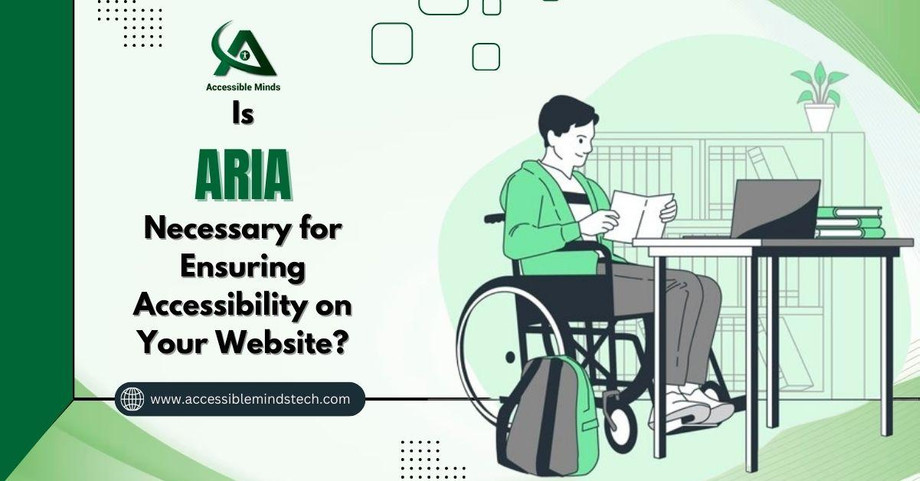In today's digital age, ensuring accessibility on websites is paramount. With the increasing emphasis on inclusivity and user experience, web developers and designers are continually striving to make their websites accessible to all users, including those with disabilities. One tool that has gained prominence in the realm of web accessibility is ARIA, or Accessible Rich Internet Applications. But is ARIA truly necessary for ensuring accessibility on your website? Let's delve deeper into this question.
Understanding Web Accessibility Services
Before we delve into the significance of ARIA, it's essential to grasp the broader concept of web accessibility services. Web Accessibility services encompass a range of practices and technologies aimed at making web content and applications accessible to people with disabilities. These disabilities may include visual impairments, auditory impairments, motor disabilities, cognitive disabilities, and more. By adhering to web
accessibility standards, websites can ensure that all users, regardless of their abilities, can perceive, navigate, and interact with the content effectively.
What is ARIA?
Accessible Rich Internet Applications (ARIA) is a set of attributes designed to enhance the accessibility of web content and applications, particularly for users with disabilities. Developed by the World Wide Web Consortium (W3C), ARIA provides a standardized way to convey additional semantic information about the behavior, structure, and purpose of elements on a web page.
ARIA attributes can be added to HTML elements to supplement their native semantics and improve their interpretation by assistive technologies such as screen readers and keyboard navigation tools. These attributes include roles, properties, and states, which help assistive technologies understand the purpose and functionality of interactive elements.
One of the primary objectives of ARIA is to bridge the accessibility gap between traditional web applications and the capabilities of assistive technologies. Many modern web applications utilize dynamic content, custom widgets, and interactive elements that may not be adequately conveyed to users with disabilities using standard HTML alone. ARIA addresses this challenge by providing a mechanism to describe complex user interface components in a way that is accessible to all users.
For example, ARIA roles can be used to designate elements as landmarks (such as headers, navigation bars, and footers), form controls (such as buttons, checkboxes, and input fields), or live regions (dynamic areas of content that may be updated without requiring user interaction). By adding these semantic annotations to HTML elements, developers can ensure that assistive technologies provide accurate and meaningful feedback to users, thereby improving the overall accessibility of their web applications.
In essence, ARIA serves as a crucial tool in the pursuit of universal web accessibility, empowering developers to create more inclusive and user-friendly digital experiences for individuals of all abilities.
The Role of ARIA in Web Accessibility
While ARIA is not a silver bullet for achieving web accessibility, it plays a crucial role in enhancing the accessibility of dynamic and interactive web content. Traditional HTML elements may not always convey the necessary information or functionality to users of assistive technologies. ARIA fills this gap by providing additional context and structure to elements such as menus, sliders, tabs, and live regions.
By leveraging ARIA attributes such as roles, properties, and states, web developers can ensure that assistive technologies interpret the content correctly and convey it to users in a meaningful way. For example, the role="button" attribute can be used to identify a clickable element as a button, allowing screen readers to announce it as such to users who rely on auditory feedback.
When is ARIA Necessary?
While ARIA can significantly improve the accessibility of web content, it's essential to use it judiciously and in conjunction with best practices in web development. ARIA should be employed when standard HTML elements alone are insufficient to convey the intended meaning or functionality of interactive elements. Complex widgets, custom controls, and dynamic content are typical scenarios where ARIA proves invaluable in enhancing accessibility.
For example, consider a custom dropdown menu created using div elements and JavaScript. Without ARIA attributes, assistive technologies may not recognize the dropdown as a menu or convey its options to users effectively. By incorporating ARIA roles such as "role='menu'" and "role='menuitem'", developers can ensure that screen readers interpret the dropdown as a menu with selectable items, improving its accessibility for users with disabilities.
Similarly, ARIA can be essential in enhancing the accessibility of single-page applications (SPAs) and web applications that rely heavily on JavaScript and AJAX to dynamically update content. In such cases, ARIA live regions can be used to announce changes to users in real-time, ensuring that individuals using assistive technologies stay informed about updates, alerts, and notifications without relying solely on visual cues.
However, it's crucial to note that over-reliance on ARIA or incorrect implementation can lead to accessibility issues rather than solutions. Misuse of ARIA attributes can confuse assistive technologies and result in an inconsistent or inaccessible user experience. Therefore, web developers should have a solid understanding of ARIA and its proper usage guidelines to leverage its benefits effectively.
Conclusion
In conclusion, while ARIA is not a panacea for web accessibility, it is undeniably a valuable tool in the toolkit of web developers striving to create inclusive digital experiences. When used appropriately, ARIA can enhance the accessibility of dynamic and interactive web content, making it more usable for individuals with disabilities. However, it should be employed judiciously and in conjunction with other best practices in web development to ensure optimal results.
By incorporating ARIA into your website's development process, you can contribute to a more accessible and equitable online environment for everyone.

